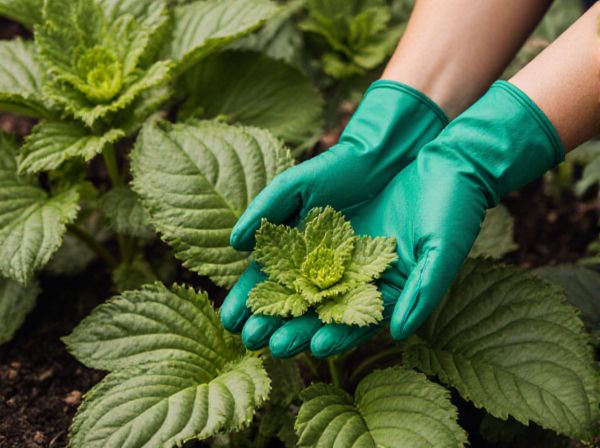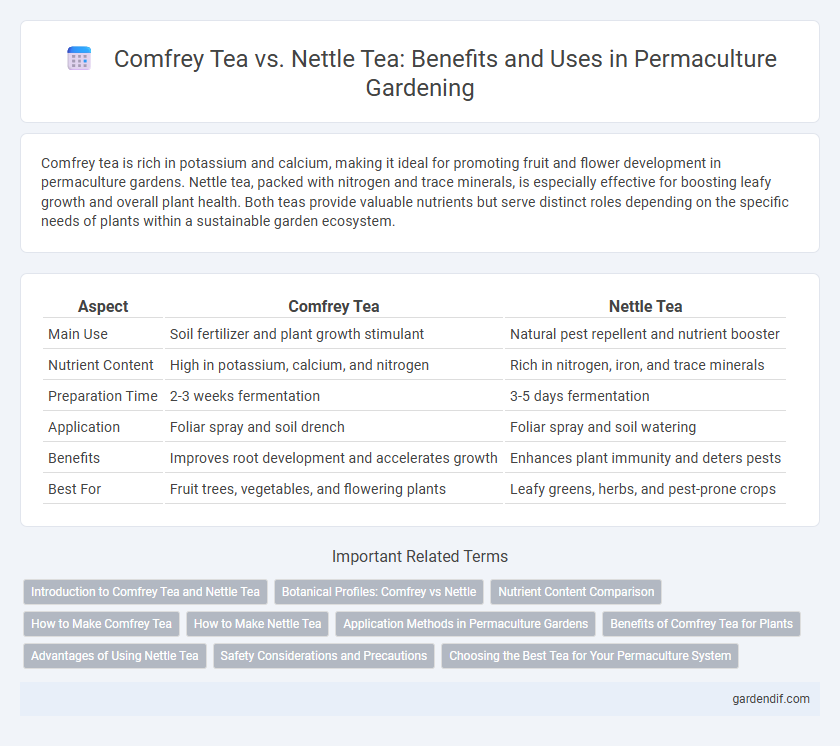
Comfrey Tea vs Nettle Tea Illustration
Comfrey tea is rich in potassium and calcium, making it ideal for promoting fruit and flower development in permaculture gardens. Nettle tea, packed with nitrogen and trace minerals, is especially effective for boosting leafy growth and overall plant health. Both teas provide valuable nutrients but serve distinct roles depending on the specific needs of plants within a sustainable garden ecosystem.
Table of Comparison
| Aspect | Comfrey Tea | Nettle Tea |
|---|---|---|
| Main Use | Soil fertilizer and plant growth stimulant | Natural pest repellent and nutrient booster |
| Nutrient Content | High in potassium, calcium, and nitrogen | Rich in nitrogen, iron, and trace minerals |
| Preparation Time | 2-3 weeks fermentation | 3-5 days fermentation |
| Application | Foliar spray and soil drench | Foliar spray and soil watering |
| Benefits | Improves root development and accelerates growth | Enhances plant immunity and deters pests |
| Best For | Fruit trees, vegetables, and flowering plants | Leafy greens, herbs, and pest-prone crops |
Introduction to Comfrey Tea and Nettle Tea
Comfrey tea, made from the leaves of Symphytum officinale, is rich in potassium and promotes vigorous plant growth and flowering in permaculture gardens. Nettle tea, derived from Urtica dioica, is high in nitrogen and trace minerals, enhancing soil fertility and supporting leafy green development. Both organic liquid fertilizers improve soil health and plant resilience when applied regularly.
Botanical Profiles: Comfrey vs Nettle
Comfrey (Symphytum officinale) features large, hairy leaves and deep roots rich in allantoin, promoting soil health and plant growth, while nettle (Urtica dioica) possesses serrated, stinging leaves loaded with nitrogen, iron, and calcium, enhancing nutrient availability. Comfrey tea serves as a potent organic fertilizer supplying potassium and phosphorus, whereas nettle tea acts as a natural insect repellent and foliar feed high in micronutrients. Both botanical profiles contribute uniquely to permaculture systems by improving soil fertility and plant resilience.
Nutrient Content Comparison
Comfrey tea is rich in potassium, calcium, and nitrogen, making it highly effective for promoting vigorous plant growth and enhancing soil fertility. Nettle tea offers a balanced nutrient profile with high levels of nitrogen, iron, and trace minerals that improve leafy vegetable development and overall plant health. Comparing both, comfrey tea excels in potassium and calcium content, while nettle tea provides superior nitrogen and micronutrients important for plant metabolism.
How to Make Comfrey Tea
To make comfrey tea, harvest fresh comfrey leaves, chop them finely and soak in water for 1-2 weeks to allow nutrient extraction through fermentation. Strain the liquid and dilute with water at a ratio of 1:10 before applying as a foliar feed or soil drench. This nutrient-rich tea provides potassium, calcium, and nitrogen, promoting vigorous plant growth and soil fertility in permaculture systems.
How to Make Nettle Tea
To make nettle tea for permaculture use, harvest young stinging nettle leaves and steep them in hot water for 10-15 minutes, allowing the infusion to extract essential nutrients like nitrogen, potassium, and iron. Strain the mixture thoroughly to remove all plant matter before applying the liquid as a natural fertilizer and soil conditioner. This nutrient-rich nettle tea promotes vigorous plant growth and enhances soil microbial activity, making it a valuable input in sustainable garden management.
Application Methods in Permaculture Gardens
Comfrey tea is primarily applied as a nutrient-rich foliar spray or soil drench to promote vigorous plant growth and improve soil fertility due to its high levels of potassium and nitrogen. Nettle tea, rich in iron and nitrogen, is commonly used as a foliar feed and natural pest deterrent, enhancing plant immunity and deterring aphids and other insects. Both teas can be integrated into permaculture garden cycles, with comfrey tea favored for soil enrichment and nettle tea for pest control and leaf nourishment.
Benefits of Comfrey Tea for Plants
Comfrey tea is rich in potassium, calcium, and nitrogen, essential nutrients that promote vigorous plant growth and improve soil fertility. Its natural growth stimulants accelerate root development and enhance the plant's ability to withstand stress. Compared to nettle tea, comfrey tea provides a more balanced nutrient profile, making it ideal for boosting vegetable garden yields and supporting perennial plants.
Advantages of Using Nettle Tea
Nettle tea is rich in nitrogen, potassium, and trace minerals essential for promoting robust plant growth and improving soil fertility in permaculture systems. Its natural pest-repellent properties help protect crops from harmful insects while enhancing microbial activity in the soil. Using nettle tea supports sustainable farming by boosting plant resilience and nutrient cycling without chemical inputs.
Safety Considerations and Precautions
Comfrey tea contains pyrrolizidine alkaloids that can cause liver damage if ingested in large amounts, so it is recommended for external use only in permaculture practices. Nettle tea is generally safe for consumption but may cause allergic reactions or interact with medications, requiring caution for individuals with sensitive skin or pre-existing conditions. Both teas should be prepared carefully, avoiding contaminated water sources to prevent microbial risks and ensuring they are used appropriately to maximize benefits in sustainable gardening.
Choosing the Best Tea for Your Permaculture System
Comfrey tea provides a rich source of potassium, calcium, and nitrogen, making it ideal for promoting vigorous plant growth and improving soil fertility in permaculture systems. Nettle tea offers high levels of iron, magnesium, and trace minerals that enhance plant immunity and deter pests naturally. Selecting between comfrey and nettle tea depends on specific soil nutrient needs and plant species, optimizing nutrient cycling and sustainability in your garden ecosystem.
Comfrey Tea vs Nettle Tea Infographic

 gardendif.com
gardendif.com